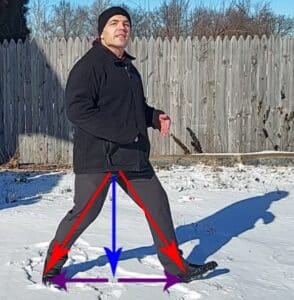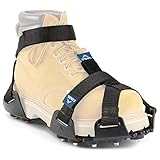Slipping and falling on ice in the winter can be dangerous, or in some cases even deadly. Watch this video to learn how to prevent slipping and falling on ice in the winter.
The Importance of Preventing Slips and Falls On Ice
Before delving into prevention strategies, it's crucial to understand the significance of winter safety.
While staying indoors is the safest option, sometimes it's unavoidable to venture out in snowy or icy conditions.
Whether it's a necessary commute or a desire to enjoy winter activities, learning how to navigate icy surfaces is essential.
Understanding the Science of Friction
Contrary to popular belief, balance alone isn't sufficient to prevent slips on ice.
The key lies in understanding the science of friction.
Friction is the force that prevents sliding.
Its mathematical equation involves the force perpendicular to the ground (the "Normal" force) times the coefficient of friction.
Surfaces like pure ice or black ice have a low coefficient of friction, making them prone to easy sliding.
Choosing the Right Non-Slip Footwear
The first line of defense against slipping on ice is wearing appropriate footwear.
Opt for shoes made with rubber soles and ample traction.
This enhances the friction between the ground and your shoe, providing a more secure grip.
Consider looking for areas covered with dirt, salt, or even snow (vs. pure ice), as these elements contribute to increased friction.
Stepping Techniques To Avoid Slipping and Falling On Ice
When walking on ice, it's essential to adopt specific stepping techniques to maximize safety.
Take shorter steps to ensure a perpendicular force that translates your body weight into creating friction.
Larger steps may lead to a sliding force as part of your weight goes parallel to the surface.
Additionally, focus on stepping with a flat foot to increase the contact area between your foot and the ground. This, combined with shorter steps, minimizes sliding forces.
Avoid heel striking, as it reduces the contact area and compromises friction.
Applying these principles becomes even more critical when navigating hills, as the steeper the incline, the greater the downward sliding force.
Using Ice Cleats Can Help Prevent Slipping and Falling
For those who spend considerable time outdoors in snowy and icy conditions, investing in ice cleats can provide an added layer of safety.
Various brands are available, but Consumer Reports has rated STABILicers Maxx as one of the best options.
STABILicers Maxx 2 Heavy-Duty Traction C...
7% OffIce cleats enhance traction, providing stability and reducing the risk of slipping.
Conclusion
By applying these tips this winter, you can help prevent slipping and falling on ice.
By choosing the right footwear, adopting proper stepping techniques, and considering additional aids like ice cleats, you can significantly reduce the risk of slips and falls.
Remember to prioritize safety, take shorter steps, and be vigilant when navigating icy surfaces.
Need Help For Slipping and Falling?
If you need help to improve your balance or to recover from an injury after a fall, we'd be happy to help you.
Just tap the button below to request an appointment with one of our specialist physical therapists.
Here are some other posts about how to improve poor balance with age that you may enjoy:
Spinal Stenosis And Walking Problems
3 Best Balance Exercises For Seniors To Improve Balance At Home
3 Strengthening Exercises For Ankle Stability and Balance




